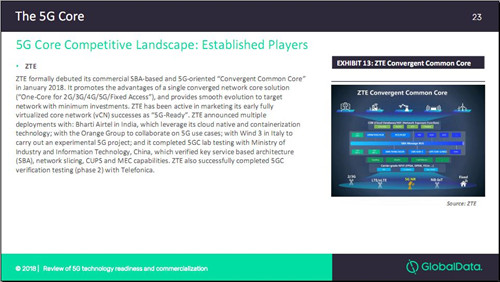ZTE, Established Player of 5G CORE, 5G RAN, 5G TRANSPORT
Time:2019-02-18
rated by GlobalData in its latest resport - 5G: Review of 5G technology readiness and commercialization

ZTE 5G Common Core can meet the following market requirements of 5G Core
• Cloud-native VNFs
While not a direct consequence of 5GC requirements, the service agility targeted by the SBA demands a new breed of network function: “cloud-native” Virtual Network Functions (VNFs). At a minimum, cloud-native VNFs, provide clear separation between application logic and application data, are microservices-based, provide smaller functional and reusable logic components and are capable of easy on-boarding and orchestration within the 5GC.
• Common VNF Data Management
A common ‘VNF data management’ is required for the uniform management of application data across the 5GC. VNF data needs to be accessible across the entire core network infrastructure (which may extend to the edge of the physical network) and facilitates VNF scaling, failover and upgrade. Additionally it exposures network data via standard Application Programming Interfaces (APIs) to for network optimization or network monetization.
• Network Slice Orchestration
‘Network slicing’ is the process of creating and managing virtual network slices which reside on the physical network, this applies to the access and core networks. From a core network perspective, the AMF includes the Network Slice Selection Function (NSSF) and all network functions registered in the NRF must also have a ‘slice identifier’. 5G end-to-end slice orchestration is an extension of ETSI’s existing NFV Management and Network Orchestration (MANO) architectural framework.
• Control & User Plane Separation (CUPS)
CUPS splits the core network’s control and user planes to enable clear functional separation and independent resource scaling. As Exhibit 6 shows, the new SBA decouples the core from access networks. It also enables core network functionality nearer the network edge to meet stringent 5G latency requirements. CUPS is already being introduced into 4G enhanced packet core (EPC) networks providing the basis of an smooth migration path from 4G to 5G core networks.
• Towards One Converged Core Network
Technologies are now in place to evolve the operator core network to support 2G, 3G, 4G and 5G access networks. These include, for example, 3G/4G IMS service cores implemented as network slices, sliced packet cores for specific 5G verticals and even virtualized 2G/3G fixed/mobile softswitches implemented as cloud-native VNFs.
• Evolution not Revolution
The SBA-based 5G Core represents a radical step change in network design, but getting there must be a smooth process. The 5G network core must be capable of supporting multiple generations of both mobile and fixed access. There are two emerging architectural features of existing core networks, which will help in this process. The first is NFV (see previous slide) and the second, Control & User Plane Separation (CUPS).
For more details, you may visit the following link https://technology.globaldata.com/Analysis/details/5g-review-of-5g-technology-readiness-and-commercialization?recType=25003&subreportType=10018-10020&industryTaxonomy=300020-300025&h=Global%20IT%20and%20Telecom

